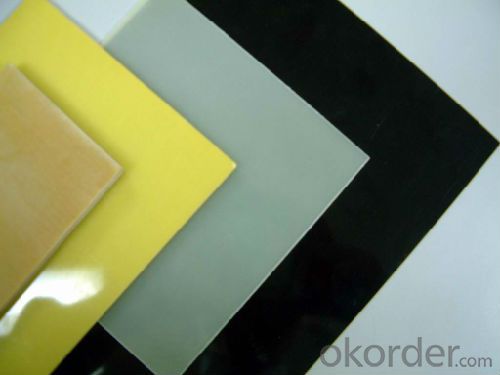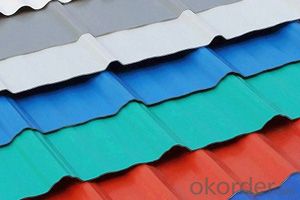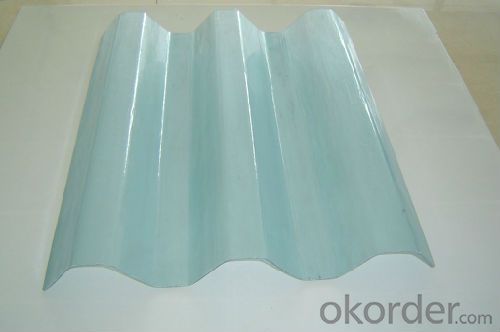FIBER REINFORCE PLASTIC REINFORCED ROOFING
- Loading Port:
- Tianjin
- Payment Terms:
- TT or LC
- Min Order Qty:
- 10000 m.t.
- Supply Capability:
- 100000 m.t./month
OKorder Service Pledge
OKorder Financial Service
You Might Also Like
Specifications
Easy Reliable Installation
green initiative
thermal insulation and insulating
color fidelity lasting

Detailed Product Description
1.Easy Reliable Installation
2.green initiative
3.thermal insulation
4.color fidelity lasting.long service life
5.Heat and sound insulation
6.Strong mechanical capacity

ASA roof tile
Shengyu synthetic resin roofing tile coated with ASA resin, is aspecial 3-layer co-extruded roofing tile. As the top layer material, ASAanti-climate engineering resin is extraordinary suitable for outdoor use. Thespecifi technical performances permit installation of the tile both industrialand civil applcations. Synthetic resin roofing tile has been exported in largequantity to Europe, Africa, South America, Asia, etc..
Long service time, Traditional appearance, Anti-corrosion, Rich color, Easyto install, Sturdy slab, Resistant to wind
Specification
Type | Royal |
Thickness | 3.0mm |
Width | 720mm |
Length | the multiple of 219mm |
Weight | 6kg±0.1kg |
Surface | Matte or Glazed |
Color | China Red, Red, Dark Red, Grey, Black, Terracotta |
Performance
As top layer material, Geloy engineering resinmade by GE is extraordinarily suitable for outdoor use. Even exposed toultra-violet radiation, dampness, heat, chillness and impact, the productsremain the stability of color and physical properties. Tests held in Aging Testcenter of Arizona and Florida prove that is less than 5 within 10 years.
Royal roof tile has passed 10,000h accelerated aging test in China NationalCenter for Test of Chemical Building Materials. The test result of Shengyu Royal tile is 3.85.

Anti-impact and Low Temperature Resistant
Falling sphere impact test: a 1kg steel ball falls freely from height of 2meters onto Royal tile, which has no crack. The tile is impacted by the fallingsphere for ten times at low temperature without damage. After ten cycles offreeze and melting, there is no swelling, frothiness, peeling-off or crack.
Anti-corrosion performance
Geloy ASA resin Royal roof tile has great performance in anti-corrosion test,which will not decline by erosion of rain and snow. Geloy resin is resistant tomany chemicals such as acid, alkali, salt, etc. Therefore, it is suitable foroutdoor application in costal area with serious salt fog corrosion and areawith heavy air pollution.
Self-cleaning
The surface of Royal roof tile is dense and smooth, being of lotus effect. Itdoesn't absorb dust after rain, thus it stays as clean as new.
Anti-load
Royal tile has strong anti-load performance. The test, conducted by ShanghaiMunicipal Building Material Component Quality Supervision and Test Station,proves that in condition of 660mm supporting span and 150kg applied load, thereis no crack in the tile.
Light Weight
One standard piece of 720mm Royal roof tile weighs 5.8±0.1kg, against apiece of 1050mm Roma roof tile 6.1±0.1kg.
Environment-friendly
With China Environmental labeling product Certificate, this product can becompletely recycled.
- Q:Can FRP pultrusion profiles be used in renewable energy projects?
- Yes, FRP (Fiber Reinforced Polymer) pultrusion profiles can certainly be used in renewable energy projects. FRP pultrusion profiles offer a wide range of advantages that make them suitable for various applications within the renewable energy sector. Firstly, FRP pultrusion profiles are lightweight yet strong, making them ideal for use in wind turbine blades. The lightweight nature of FRP materials allows for increased efficiency in wind energy generation by reducing the load on the turbine, thus improving overall performance. Additionally, the high strength-to-weight ratio of FRP profiles ensures durability and longevity, even in harsh environmental conditions. Secondly, FRP pultrusion profiles exhibit excellent corrosion resistance, making them suitable for solar panel mounting structures and other components exposed to moisture and outdoor elements. This corrosion resistance ensures that FRP profiles maintain their structural integrity and performance over an extended period of time, reducing the need for frequent maintenance and replacement. Thirdly, FRP pultrusion profiles can be customized to meet specific project requirements, allowing for flexibility in design and functionality. They can be easily molded into complex shapes and sizes, enabling the creation of innovative and efficient solutions for renewable energy projects. Moreover, FRP materials are non-conductive and have excellent electrical insulation properties, making them suitable for use in electrical enclosures and support structures for renewable energy systems such as solar power plants. In conclusion, FRP pultrusion profiles can be effectively utilized in renewable energy projects due to their lightweight, strong, corrosion-resistant, customizable, and electrically-insulating properties. These characteristics make FRP profiles a reliable and sustainable choice for various applications within the renewable energy sector.
- Q:What are the features of Glass Fiber Reinforced Plastic Pultruded materials and chairs?
- Glass fiber reinforced plastic extruded sections for chair bars, corrosion resistance, aging resistance, good decorative (wood grain glass fiber reinforced plastic), Candice's color wood grain felt.No recycling value. I'd say that's probably the best feature right now. Installed, no one cares about, will not lose!
- Q:Are FRP pultrusion profiles resistant to sulfuric acid?
- FRP (Fiber Reinforced Polymer) pultrusion profiles are generally resistant to sulfuric acid. The corrosion resistance of FRP profiles is one of their key advantages compared to traditional materials like steel or concrete. Sulfuric acid is a highly corrosive substance, but FRP pultrusion profiles can withstand its effects due to the inherent properties of the composite materials used in their construction. The corrosion resistance of FRP profiles is mainly attributed to the resin matrix that encapsulates the reinforcing fibers. Most commonly used resins in pultrusion, such as polyester, vinyl ester, or epoxy, have excellent chemical resistance properties, including resistance to sulfuric acid. However, it is important to note that the resistance of FRP pultrusion profiles to sulfuric acid can vary depending on several factors. The concentration and temperature of the acid, as well as the specific resin formulation used in the profile, can influence the overall resistance. In highly concentrated or elevated temperature environments, it is advisable to consult with the manufacturer or supplier to ensure the specific FRP profile meets the required resistance level. In general, FRP pultrusion profiles offer a high level of resistance to sulfuric acid, making them suitable for various applications in industries where this corrosive substance may be present, such as chemical processing, wastewater treatment, or mining.
- Q:Are FRP pultrusion profiles resistant to impact from flying debris?
- Yes, FRP pultrusion profiles are highly resistant to impact from flying debris. Thanks to their reinforced fiberglass construction, these profiles have exceptional strength and durability, making them capable of withstanding significant impact forces without incurring damage.
- Q:Are FRP pultrusion profiles resistant to chemicals used in food packaging?
- Yes, FRP pultrusion profiles are generally resistant to the chemicals commonly used in food packaging. The combination of fiberglass reinforcement and resin matrix used in FRP profiles provides excellent chemical resistance, making them a suitable choice for applications involving contact with food packaging chemicals. However, it is always recommended to consult with the manufacturer or supplier to ensure specific compatibility with the chemicals involved.
- Q:Are FRP pultrusion profiles resistant to biological growth, such as mold or mildew?
- Yes, FRP (Fiber Reinforced Polymer) pultrusion profiles are highly resistant to biological growth, including mold and mildew. FRP materials are inherently non-porous, making it difficult for microorganisms to attach and grow on their surface. Additionally, FRP pultrusion profiles are typically manufactured using a combination of resin and glass fibers, which are both naturally resistant to biological growth. Unlike traditional materials such as wood or metal, FRP does not provide an ideal environment for mold or mildew to thrive. The smooth and non-porous surface of FRP profiles prevents moisture absorption, which is essential for the growth of microorganisms. Furthermore, FRP materials do not contain organic compounds that can support the growth of mold or mildew, making them highly resistant to biological degradation. In applications where resistance to biological growth is crucial, FRP pultrusion profiles offer a significant advantage over alternative materials. They are commonly used in environments with high humidity, moisture, or exposure to water, such as marine, agricultural, or wastewater treatment facilities. Additionally, FRP profiles are frequently employed in indoor applications where mold or mildew growth can be a concern, such as in sanitary areas or food processing plants. Overall, FRP pultrusion profiles provide excellent resistance to biological growth, including mold and mildew. Their non-porous nature, combined with the inherent resistance of the materials used in their manufacturing, make them a durable and long-lasting solution in environments where microbial growth is a potential issue.
- Q:What are the limitations of FRP pultrusion profiles?
- Some limitations of FRP pultrusion profiles include limited design flexibility, susceptibility to UV degradation, potential for delamination or fiber breakage under high impact or bending loads, and difficulty in achieving complex geometries. Additionally, FRP pultrusion profiles may have higher initial costs compared to traditional materials, and the availability of large-scale production may be limited.
- Q:Can FRP pultrusion profiles be used in wastewater treatment facilities?
- Yes, FRP pultrusion profiles can be used in wastewater treatment facilities. FRP (Fiber Reinforced Plastic) pultrusion profiles are known for their high strength, corrosion resistance, and durability, making them suitable for various applications, including in harsh environments like wastewater treatment facilities. These profiles can be used for constructing structures, such as walkways, handrails, grating, and tanks, as well as for reinforcing or replacing traditional materials, such as steel or concrete, in different components of the facility. The corrosion resistance of FRP pultrusion profiles ensures their longevity and reduces maintenance costs, making them a viable option for wastewater treatment facilities.
- Q:Can FRP pultrusion profiles be used for structural applications?
- Certainly, FRP pultrusion profiles can be utilized for structural purposes. The process of pultrusion involves pulling fiber reinforcements through a resin bath and a heated die to cure the resin, resulting in robust, lightweight, and corrosion-resistant profiles with exceptional mechanical properties. The high strength-to-weight ratio of FRP pultrusion profiles makes them widely employed in different structural applications. These profiles can be engineered to possess specific load-bearing capacities, stiffness, and durability, making them suitable for a wide range of structural requirements. FRP pultrusion profiles find common use in various structural applications such as bridges, walkways, platforms, handrails, supports, beams, columns, and reinforcements in concrete structures. They are particularly advantageous in situations where traditional materials like steel or wood are unsuitable due to concerns regarding corrosion, electrical conductivity, or weight. The benefits of FRP pultrusion profiles are numerous. They are lightweight, making them easy to handle and transport. Furthermore, they exhibit resistance to corrosion, chemicals, and UV radiation, ensuring long-term durability even in harsh environments. Additionally, they possess excellent dimensional stability, remaining unaffected by warping, twisting, or shrinking over time. To summarize, FRP pultrusion profiles are highly suitable for structural applications owing to their strength, lightweight nature, corrosion resistance, and durability. They provide a cost-effective alternative to traditional materials while delivering superior performance in various structural projects.
- Q:Are FRP pultrusion profiles UV-resistant?
- FRP pultrusion profiles are known for their UV resistance. This is because they are made by combining reinforcing fibers, like glass or carbon, with a polymer matrix, such as polyester or vinyl ester. These materials naturally resist UV radiation, allowing FRP pultrusion profiles to endure long exposure to sunlight without significant deterioration or loss of mechanical properties. However, it's important to note that the UV resistance of FRP pultrusion profiles can vary based on the polymer matrix's type and quality used in their manufacturing. Thus, it is recommended to consult the manufacturer or supplier for detailed information regarding the UV resistance of specific FRP pultrusion profiles.
1. Manufacturer Overview |
|
|---|---|
| Location | |
| Year Established | |
| Annual Output Value | |
| Main Markets | |
| Company Certifications | |
2. Manufacturer Certificates |
|
|---|---|
| a) Certification Name | |
| Range | |
| Reference | |
| Validity Period | |
3. Manufacturer Capability |
|
|---|---|
| a)Trade Capacity | |
| Nearest Port | |
| Export Percentage | |
| No.of Employees in Trade Department | |
| Language Spoken: | |
| b)Factory Information | |
| Factory Size: | |
| No. of Production Lines | |
| Contract Manufacturing | |
| Product Price Range | |
Send your message to us
FIBER REINFORCE PLASTIC REINFORCED ROOFING
- Loading Port:
- Tianjin
- Payment Terms:
- TT or LC
- Min Order Qty:
- 10000 m.t.
- Supply Capability:
- 100000 m.t./month
OKorder Service Pledge
OKorder Financial Service
Similar products
New products
Hot products
Related keywords





























